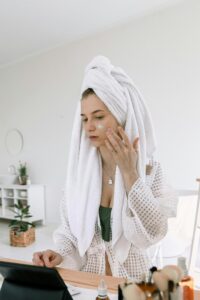pic from
**What is Fungal Acne and How to Get Rid of It for Good**
—
Are you battling those stubborn little bumps on your skin that just won’t go away, even after trying multiple acne treatments? It might not be typical acne but something called **fungal acne**. This condition is often misunderstood and, unfortunately, mistreated. Here’s everything you need to know to identify, treat, and prevent fungal acne effectively.
—
### What Exactly is Fungal Acne?
Unlike regular acne, which is caused by bacteria, **fungal acne (also known as Malassezia folliculitis)** is triggered by an overgrowth of yeast called *Malassezia*. This yeast lives on everyone’s skin but can become problematic when it overgrows, leading to tiny, itchy bumps, usually on the chest, back, and sometimes the face. If you’ve tried everything for your acne, but it’s not responding, there’s a good chance you’re dealing with fungal acne instead of bacterial.
**Symptoms to Look Out For:**
– Small, uniform red or white bumps
– Persistent itchiness
– Commonly appears on chest, back, and shoulders
– Often confused with bacterial acne, so it doesn’t improve with typical acne treatments
—
### What Causes Fungal Acne?
Fungal acne thrives when certain conditions disrupt the balance of yeast and bacteria on your skin. Knowing these triggers can help you avoid future breakouts:
**Common Triggers:**
– **Excessive sweating**: Hot, humid environments make fungal acne worse.
– **Tight, non-breathable clothing**: Traps moisture and creates an ideal environment for yeast.
– **Oily skincare products**: Some oils can feed the yeast, leading to an overgrowth.
– **Antibiotic use**: Antibiotics can kill good bacteria on the skin, giving yeast the upper hand.
Adjusting your lifestyle and skincare can play a significant role in managing fungal acne. Opt for loose, breathable fabrics and try to shower immediately after sweating.
—
How to Get Rid of Fungal Acne: Treatment Options
If you’re ready to tackle fungal acne, here’s a combination of treatments and lifestyle adjustments that can make a big difference.
#### Over-the-Counter Treatments
1. **Ketoconazole Shampoo**: Use it as a body wash on affected areas. Let it sit for a few minutes before rinsing.
2. **Selenium Sulfide**: Often found in dandruff shampoos, this ingredient has antifungal properties that help reduce yeast growth.
3. **Sulfur-Based Products**: Sulfur can be applied as a mask to kill yeast on the skin.
Apply these products regularly—about twice a week to see noticeable improvement.
#### Home Remedies
– **Tea Tree Oil**: Has natural antifungal properties. Dilute it with a carrier oil and patch-test to avoid irritation.
– **Apple Cider Vinegar**: Known for its antifungal effects. Dilute with water and dab on the affected areas.
*Pro tip*: Always patch-test before trying new remedies to prevent irritation.
#### Lifestyle Adjustments
– **Wear Breathable Fabrics**: Opt for loose, cotton clothes, especially if you’re prone to sweating.
– **Shower After Sweating**: Rinsing off sweat prevents fungal growth.
– **Avoid Heavy, Oily Products**: Look for non-comedogenic or lightweight skincare that doesn’t feed yeast.
—
### When to See a Dermatologist
If over-the-counter treatments aren’t enough, a dermatologist can prescribe **oral antifungal medications** like fluconazole or itraconazole, which are more powerful in combating persistent fungal acne.
—
### FAQs about Fungal Acne
**Q: How can I tell if I have fungal acne versus regular acne?**
A: Fungal acne consists of small, uniform, itchy bumps, often resistant to typical acne treatments. Regular acne varies in size and usually isn’t as itchy.
**Q: Can fungal acne be cured completely?**
A: Yes, with the right treatment and preventive steps, you can manage and prevent fungal acne effectively.
**Q: Is it safe to use antifungal shampoos on my face?**
A: Yes, many people use antifungal shampoos like ketoconazole on their face, but patch-test first to ensure it doesn’t cause irritation.
—
Fungal acne doesn’t have to be a life sentence. With the right approach, you can kick it to the curb and keep it there! So, if you suspect fungal acne, start with these steps, and don’t hesitate to reach out to a dermatologist for targeted treatment options.
—
**Related Reads**:
– [How to Build a Simple Skincare Routine](https://girlsbeauty.us/blog/how-to-build-a-simple-skincare-routine)
– [Top Non-Comedogenic Moisturizers for Acne-Prone Skin](https://girlsbeauty.us/blog/top-non-comedogenic-moisturizers-for-acne-prone-skin)
– [Tips for Managing Acne on Your Back and Shoulders](https://girlsbeauty.us/blog/tips-for-managing-back-acne)


Leave a Reply